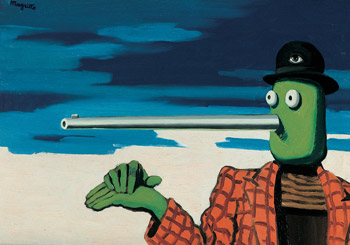René Magritte - La Famine, 1948
"I love subversive humour, freckles, knees, the long hair of women, the dreams of young children at liberty, a young girl running in the street."
René Magritte
René Magritte - Prince Charming, 1948
René Magritte numbers not only among the most important, but also among the most popular artists of the twentieth century. Often against the grain of the tendencies in the arts of his time, the Belgian Surrealist painter developed a unique and unmistakable pictorial language ... However, a fascinating period of the artist's landmark oeuvre has remained nearly unknown: his so-called période vache. In 1948, Magritte made a group of paintings and gouaches distinctly different from the rest of his work for his first solo exhibition in Paris. Relying on a new, fast and aggressive style of painting - and particularly inspired by popular sources such as caricatures and comics, but also interspersing his works with stylistic quotations from artists like James Ensor or Henri Matisse - Magritte, within only a few weeks, produced about thirty entirely uncharacteristic works that caused an outrage in Paris. The artist deliberately conceived the exhibition as a provocation of and an assault on the Parisian public. Painting in anunexpectedly crude, playful, and intentionally "bad" manner, he reflected his own work and painting in general.
http://www.artrepublic.com/exhibitions/197-rene-magritte-1948-la-periode-vache.html
René Magritte - L’Ellipse
, 1948
In 1948, Magritte made a group of paintings and gouaches distinctly different from the rest of his work for his first solo exhibition in Paris. Relying on a new, fast and aggressive style of painting – and particularly inspired by popular sources such as caricatures and comics, but also interspersing his works with stylistic quotations from artists like James Ensor or Henri Matisse – Magritte, within only a few weeks, produced about thirty entirely uncharacteristic works that caused an outrage in Paris. The artist deliberately conceived the exhibition as a provocation of and an assault on the Parisian public. Painting in an unexpectedly crude, playful, and intentionally “bad” manner, he reflected his own work and painting in general ... The term “vache” used by Magritte for his new group of works is mostly understood as an ironical allusion to the historical movement of the Fauves, whose exaggerated coloring Magritte’s works parodied as much as their decoratively pleasing character. Yet in French, “vache” does not only mean “cow,” but also as much as “mean” or “nasty”; “vacherie” signifies a mean trick. Thus, the term hints at the aggressive and deliberately crude quality characteristic of the pictures ... Regarding both their motifs and their style, the works of Magritte’s Période vache do not constitute a consistent ensemble but rather present themselves as a patchwork of different pseudo-styles borrowing more or less openly from other artists and drawing on the artist’s own earlier works. These elements are transformed into something comic, trivial, or grotesque by being blended with aspects of popular visual culture.
http://www.e-flux.com/announcements/rene-magritte-la-periode-vache/
René Magritte - The Old Soldier, 1945
Magritte’s période vache is an anachronism, an exercise in perversity in which was the celebrated artist’s response to the opportunity for a solo show in a city that he’d left in 1931 and with which he’d had a fractious relationship ever since ... On reflection, these works are an important (first?) step on a journey through painting that was joined just over two decades later by artists such as Jörg Immendorff and Georg Baselitz in Europe, or Philip Guston in the USA, and then subsequently by artists such Martin Kippenberger, Maria Lassnig, George Condo, Sean Landers and even Paul McCarthy. These figures all like to play in the same mucky sandpit of grotesque figuration, dark comedy and bawdy sexuality. It is pleasing to think of Magritte clearing the space for such an important and fruitful discourse in a brisk two-month career cul-de-sac to which he’d never return. I almost want to say that what is remarkable here is that he achieved this by making paintings that ‘didn’t really mean it’. Remembering however his comment to Scutenaire, what makes the series really extraordinary in the wily artist’s oeuvre is that he meant it too much.
http://blog.frieze.com/ceci_nest_pas_magritte/
René Magritte - The Mark, 1948
Monday, 30 April 2012
Subscribe to:
Post Comments (Atom)






No comments:
Post a Comment